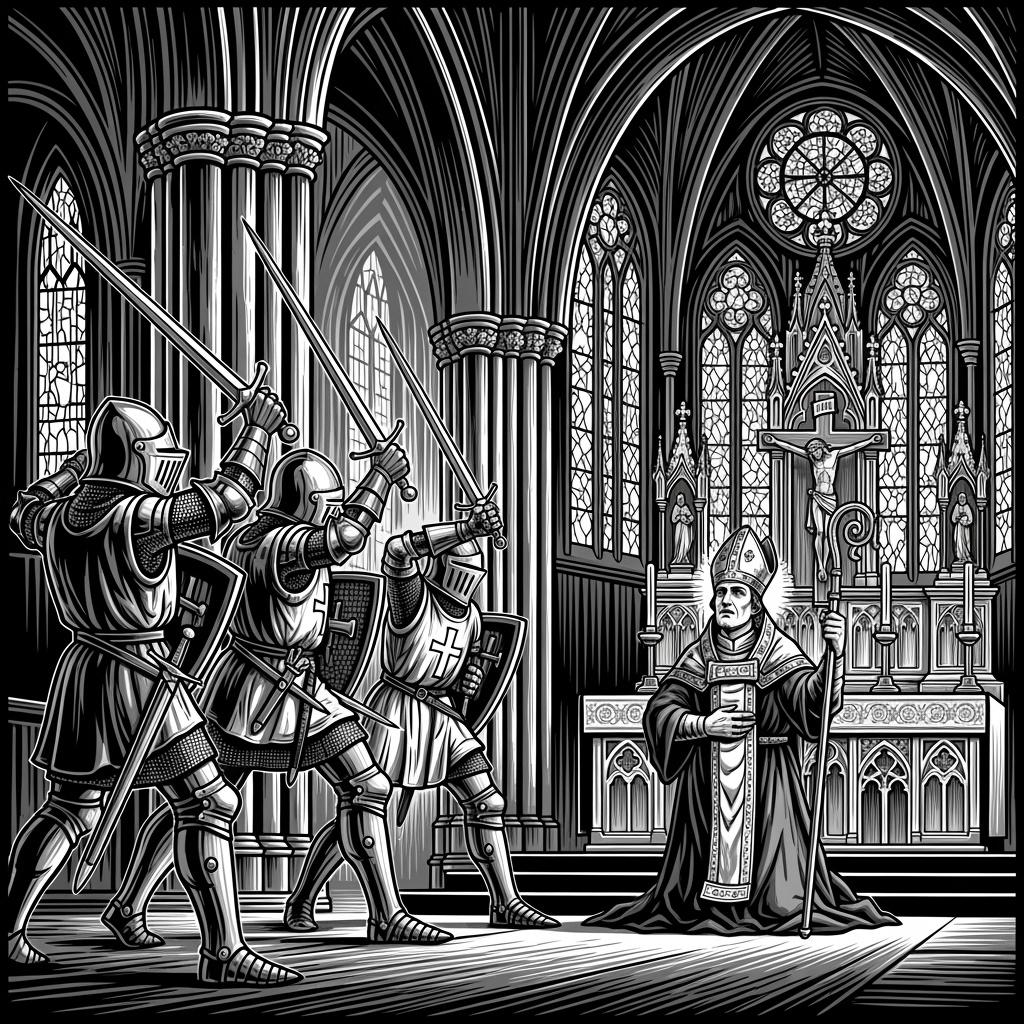850 years ago, on December 29, 1170, the Archbishop of Canterbury, Thomas Becket, was brutally murdered by four knights in his own cathedral. This murder marked the end of a close friendship between Becket and King Henry II and left a deep mark on English history, art, and literature. The relationship between Thomas Becket and King Henry II, once characterized by close cooperation and trust, developed into a dramatic feud that ultimately culminated in Becket’s death. Thomas Becket was born in London on December 21, 1119 or 1120, on the feast day of St. Thomas the Apostle, whose name he received. His parents were wealthy immigrants from Normandy, and his father was a respected merchant. Becket received an excellent education, including studies in Paris. Thanks to this education, he was able to enter the service of Archbishop Theobald of Canterbury. The turning point in his life came in 1155, when Becket was appointed Lord Chancellor to King Henry II. In this position, he developed a close relationship with the king. The two men spent a lot of time together, traveling throughout England, hunting, and enjoying the luxurious life at court. Becket was known for his lavish parties and generous hospitality. When the seat of Archbishop of Canterbury became vacant in 1162, Henry II pushed for Becket to take the position. The king hoped that Becket would continue to represent his political interests as archbishop. However, the king’s plan did not work out. After Becket took office as archbishop, he resigned as Lord Chancellor and devoted himself entirely to his ecclesiastical duties. This led to a serious rift with Henry II. Becket vehemently defended the rights and privileges of the Church against the king’s influence. This led to an increasingly bitter dispute between the two former friends. Finally, Henry II felt compelled to accuse Becket of treason. Fearing for his life, Becket fled into exile in France in 1164. He spent six years there while Henry II and Pope Alexander III negotiated indirectly about Becket’s possible return. On December 1, 1170, Becket returned triumphantly to England. His return was like a victory parade, but the tensions with the king were by no means resolved. Only a few weeks later, the conflict reached its tragic climax. Henry II’s legendary remark, “Will no one rid me of this troublesome priest?” is considered the trigger for the ensuing tragedy. Four of his knights – Reginald Fitzurse, Hugh de Morville, William de Tracy and Richard le Breton – interpreted this as a call to action. On December 29, 1170, they stormed into Canterbury Cathedral and murdered Becket in front of the altar. There are several eyewitness accounts of the murder, including the key document by the monk Edward Grim, who was so close to Becket that he himself was injured. Grim reports that the knights first wanted to capture Becket in his palace. However, when Becket sought refuge in the cathedral, they followed him there and killed him with drawn swords. The murder of Thomas Becket shocked Europe and led to one of the fastest canonizations in history. As early as February 1173, Pope Alexander III declared Becket a saint. Henry II had to do severe penance and make a pilgrimage to Canterbury, where he publicly humiliated himself. The cult surrounding Thomas Becket attracted pilgrims from all over Europe. In the summer of 1220, his remains were transferred to a magnificent shrine, which became an important place of pilgrimage. But this shrine also fell victim to history: in the course of the Reformation, Henry VIII had it destroyed in 1538. It is believed that this act was less due to a personal dislike of Becket than to the king’s general attitude toward insubordinate church representatives. The murder of Thomas Becket has also left a profound mark on art and literature. The dramatic story of friendship, conflict, and brutal murder continues to inspire writers, painters, and historians to this day. Naomi Speakman, co-curator of the “Thomas Becket” exhibition at the British Museum, aptly describes the story: “The story of Thomas Becket has all the hallmarks of a Game of Thrones plot: drama, fame, royalty, envy, revenge, and finally a brutal murder that shocked Europe.” Events and exhibitions in honor of Thomas Becket are being organized across the UK. 850 years have passed since this scandalous murder shook the world. Yet Thomas Becket remains a central figure in Britain’s cultural DNA. Both the Catholic and Anglican churches venerate him as a saint and martyr. His legacy lives on through the stories told about him, the works of art that depict him, and the historical studies that examine his life and times. The story of Thomas Becket is a reminder of how fragile human relationships can be and how dramatic twists and turns fate can take. But it also shows how individual events can affect the culture and collective memory of a country for centuries to come. Thomas Becket remains a symbol of steadfastness and faithfulness, whose legacy extends far beyond the borders of England.
By Isabella Mueller
Welcome to my journey through creativity and discovery! My name is Isabella Mueller, and I invite you to explore the fascinating creative universes I create through my blogs. Since 2020, I have been dedicating my passion to telling captivating stories that are mysterious, historical, and emotional. My goal is not only to entertain, but also to inspire reflection and awaken the spirit of discovery in each of us. At isabellas.blog, the suspense of crime stories is combined with exciting travel tips. Imagine wandering through the picturesque streets of a new city, uncovering dark secrets hidden in the shadows of its history. Every piece on my blog is designed to make the heart of every crime fiction fan beat faster while sparking curiosity about unknown places. Here, you are invited to experience the thrill of the unknown and the beauty of our world—a perfect combination for all adventure seekers! My second blog, akteq.com, is all about true, unsolved crime stories. Under the motto “akteQ: Cold Case Stories,” I reveal the eerie and often tragic stories behind unsolved cases. Together, we can explore the mysteries of the past and delve deep into the human psyche. What really happened? Who were the people behind these mysterious events? In this blog, I invite you to ask questions and find the answers that often remain hidden in the dark. You can find another exciting chapter in my blogging career at thecastles.org. Here, I embark on an enchanting journey through the history of castles and palaces. Pause for a moment as you discover the stories hidden within the walls of these ancient structures. “Explore the enchantment, discover the history – your journey begins at thecastles.org!” These words are more than just a slogan; they are an invitation to anyone who wants to combine history and magic. Be inspired by the impressive stories and the fascination of bygone eras! But that's not all! At kripo.org, you'll find a comprehensive online magazine for real criminal cases. Immerse yourself in the world of crime, learn about the real stories behind the headlines and the people who are involved in solving them. With criminal.energy, I take you on a journey through the gripping stories of true crimes in which villains are hunted, caught, and convicted. The search for justice and the confrontation with the unknown are at the center of it all. TrueCrime Blog 187.news takes you into the depths of crime. And for those who want to travel the world, wanderlust.plus offers the opportunity to explore the world, one adventure at a time. It's all about the love of exploration and the joy of discovering new cultures and landscapes. Finally, truecrime.ch invites you to discover the dark side of Switzerland and Europe: true crimes, true stories. Let's discover together the stories that shape the world around us. I look forward to accompanying you on this exciting journey and hope you will share many unforgettable moments with me!

